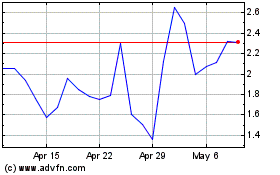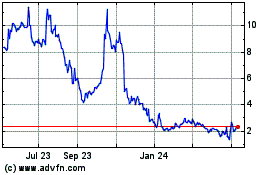Cyclacel Pharmaceuticals, Inc. (Nasdaq:CYCC) (Nasdaq:CYCCP)
(Cyclacel or the Company), a biopharmaceutical company developing
innovative medicines based on cancer cell biology, announced Phase
1 clinical data from the company's DNA damage response program with
an oral, sequential regimen of sapacitabine and seliciclib as a
treatment in patients with BRCA mutant metastatic breast cancer.
Data from the study was presented today at the 2019 American
Association for Cancer Research (AACR) Annual Meeting and
demonstrated that the regimen was safe and led to a clinical
benefit rate of 30%. All eight PARP inhibitor naïve patients, half
of the patients previously treated with platinum agents and one on
previous PARP inhibitor responded. Progression on previous platinum
or PARP inhibitors was associated with lack of benefit. Both
sapacitabine and PARP inhibitors are more effective in cancer cells
with BRCA mutations or other homologous recombination repair
deficiencies. Based on these data, the investigators are enrolling
a Phase 1b/2 study of sapacitabine in combination with a PARP
inhibitor in PARP inhibitor-naïve patients with BRCA mutant breast
cancer.
“We are encouraged by the durable responses and
stable disease in PARP inhibitor-naïve patients with BRCA mutant
metastatic breast cancer,” said Sara M. Tolaney, MD, MPH, Senior
Physician, Director, Clinical Trials, Breast Oncology, Dana-Farber
Cancer Institute, Boston and Principal Investigator of the study.
“We are very excited about the ongoing evaluation of the
combination of sapacitabine and the PARP inhibitor olaparib in PARP
inhibitor-naïve patients with metastatic BRCA mutant breast
cancer.”
Study Details
The study evaluated an oral, sequential regimen
of sapacitabine, a nucleoside analog prodrug, and seliciclib, a 1st
generation CDK2/9 inhibitor, in patients with metastatic breast
cancer harboring BRCA1/2 mutations. Patients received seven days of
sapacitabine followed by three days of seliciclib. Of 20 patients
treated, six progressed on prior platinum therapy and seven on
prior PARP inhibitor.
- Two patients achieved confirmed PR
and four SD of at least 6 months duration for an overall clinical
benefit rate of 30%. Of the two patients achieving PR, one
progressed previously on platinum treatment and one had received no
prior platinum or PARP inhibitor.
- Responses (PR or SD regardless of
duration) occurred in 12 patients: 8/8 without prior progression on
platinum or a PARP inhibitor (1 PR, 7 SDs), 3/6 patients who
progressed on platinum (1 PR, 2 SDs), and 1/7 patients who
progressed on a PARP inhibitor (1 SD).
- The most frequent grade 3 adverse
events were neutropenia (15%), AST/ALT elevation (20%), and rash
(10%). The only grade 4 adverse events were neutropenia in 2
patients.
- Progression on previous platinum
agents or PARP inhibitors was associated with lack of benefit,
putatively associated in some cases with BRCA reversion
alterations.
The poster abstract at the 2019 AACR titled
“Expansion cohort of Phase I study of oral sapacitabine and oral
seliciclib in patients with metastatic breast cancer and BRCA1/2
mutations” is available at
(https://www.abstractsonline.com/pp8/#!/6812/presentation/9865).
Both sapacitabine and PARP inhibitors are more
effective in cancer cells with BRCA mutations or other homologous
recombination repair deficiencies and combine synergistically in
preclinical models. As a result of these findings, a
concomitant administration regimen of sapacitabine and olaparib
PARP inhibitor is now being evaluated in an investigator-sponsored
trial in approximately 64 patients with PARP inhibitor-naïve,
metastatic HER2-negative breast cancer with germline BRCA1/2
mutation (https://clinicaltrials.gov/ct2/show/NCT03641755).
CYC065 AACR Poster Details
Preclinical data for Cyclacel’s CYC065 CDK2/9
inhibitor will also be presented at the 2019 AACR in a poster
titled “Next generation CDK2/9 inhibitor CYC065 triggers anaphase
catastrophe in diverse aneuploid cancers and markedly inhibits
growth and metastasis.” Researchers from MD Anderson Cancer Center
and Frederick National Laboratory for Cancer Research report that
CDK2 inhibition preferentially targets aneuploid cancer cells and
that CYC065 induces cell death in diverse cancer cell lines and
animal models, irrespective of KRAS mutation status. This CYC065
activity is demonstrated to be a consequence of CDK2/9 inhibition,
resulting in anaphase catastrophe, Mcl-1 down-regulation and
suppression of proteins that regulate metastasis
(https://www.abstractsonline.com/pp8/#!/6812/presentation/5901).
About sapacitabine
Sapacitabine (CYC682), an orally-available
nucleoside analogue, acts through a novel DNA single-strand
breaking (SSB) mechanism, leading to production of DNA double
strand breaks (DSBs) and/or checkpoint activation. Unrepaired DSBs
cause cell death. Repair of sapacitabine-induced DSBs is dependent
on the homologous recombination repair (HRR) pathway. Both
sapacitabine and its major metabolite, CNDAC, have demonstrated
potent anti-tumor activity in preclinical studies. Sapacitabine has
been studied in the SEAMLESS Phase 3 study in elderly patients with
AML who were unfit or refused intensive induction chemotherapy,
Phase 2 studies in patients with myelodysplastic syndromes (MDS),
cutaneous T cell lymphoma (CTCL) and non-small cell lung cancer
(NSCLC), Phase 1/2 studies in sequential administration with
seliciclib and concomitant administration with olaparib in patients
with BRCA mutant cancers.
About CYC065
CYC065 is a highly-selective, 2nd generation
inhibitor of cyclin dependent kinases (CDK) 2 and 9. CYC065 is in
an ongoing Phase 1, first-in-human study in patients with advanced
solid tumors. In this study target engagement and durable
suppression of the Mcl-1 biomarker were observed after a single
dose of CYC065 at the recommended phase 2 dose. CYC065 is also
being evaluated in a Phase 1 study in combination with venetoclax
in patients with relapsed/refractory CLL. Preclinical data suggest
that CYC065 may benefit patients with adult and pediatric
hematological malignancies such as CLL, AML, ALL, B-cell lymphomas,
multiple myeloma and certain cyclin E-addicted or MYC-amplified
solid tumors, including HER2+ breast cancer, uterine serous
carcinoma and neuroblastoma.
About Cyclacel Pharmaceuticals,
Inc.
Cyclacel Pharmaceuticals is a clinical-stage
biopharmaceutical company using its expertise in cell cycle,
transcriptional regulation and DNA damage response biology in
cancer cells to develop innovative medicines. The transcriptional
regulation program is evaluating CYC065, a CDK inhibitor, in
patients with advanced solid cancers and in combination with
venetoclax in patients with advanced hematological malignancies,
including CLL and AML. The DNA damage response program is
evaluating a sequential regimen of sapacitabine and seliciclib, a
CDK inhibitor, in BRCA positive patients with advanced solid
cancers and a concomitant regimen of sapacitabine and olaparib, a
PARP inhibitor, in BRCA positive patients with breast cancer.
CYC140, a PLK inhibitor, is in a Phase 1 first-in-human study in
patients with advanced leukemias. Cyclacel's strategy is to build a
diversified biopharmaceutical business focused in hematology and
oncology based on a pipeline of novel drug candidates. For
additional information, please visit www.cyclacel.com.
Forward-looking Statements
This news release contains certain
forward-looking statements that involve risks and uncertainties
that could cause actual results to be materially different from
historical results or from any future results expressed or implied
by such forward-looking statements. Such forward-looking statements
include statements regarding, among other things, the efficacy,
safety and intended utilization of Cyclacel's product candidates,
the conduct and results of future clinical trials, plans regarding
regulatory filings, future research and clinical trials and plans
regarding partnering activities. Factors that may cause actual
results to differ materially include the risk that product
candidates that appeared promising in early research and clinical
trials do not demonstrate safety and/or efficacy in larger-scale or
later clinical trials, trials may have difficulty enrolling,
Cyclacel may not obtain approval to market its product candidates,
the risks associated with reliance on outside financing to meet
capital requirements, and the risks associated with reliance on
collaborative partners for further clinical trials, development and
commercialization of product candidates. You are urged to consider
statements that include the words "may," "will," "would," "could,"
"should," "believes," "estimates," "projects," "potential,"
"expects," "plans," "anticipates," "intends," "continues,"
"forecast," "designed," "goal," or the negative of those words or
other comparable words to be uncertain and forward-looking. For a
further list and description of the risks and uncertainties the
Company faces, please refer to our most recent Annual Report on
Form 10-K and other periodic and other filings we file with
the Securities and Exchange Commission and are available
at www.sec.gov. Such forward-looking statements are current
only as of the date they are made, and we assume no obligation to
update any forward-looking statements, whether as a result of new
information, future events or otherwise.
Contacts
| Company: |
Paul McBarron, (908)
517-7330, pmcbarron@cyclacel.com |
| Investor
Relations: |
Russo Partners LLC,
Alexander Fudukidis, (646)
942-5632,alex.fudukidis@russopartnersllc.com |
© Copyright 2019 Cyclacel Pharmaceuticals, Inc. All
Rights Reserved. The Cyclacel logo and Cyclacel® are trademarks of
Cyclacel Pharmaceuticals, Inc. Ibrance® is a registered
trademark of Pfizer, Inc.
Cyclacel Pharmaceuticals (NASDAQ:CYCC)
Historical Stock Chart
From Mar 2024 to Apr 2024

Cyclacel Pharmaceuticals (NASDAQ:CYCC)
Historical Stock Chart
From Apr 2023 to Apr 2024
